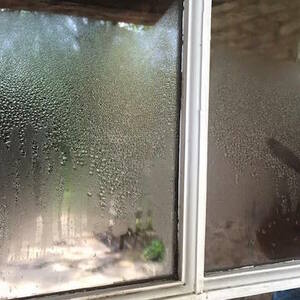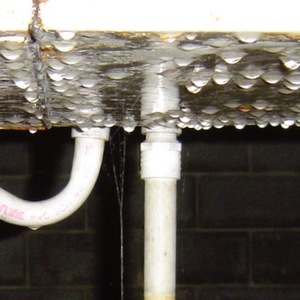Image Credit: Energy Vanguard
Image Credit: Energy Vanguard The condensation on this duct in a vented crawl space is an example of accidental dehumidification in summer.
Image Credit: Energy Vanguard The accidental dehumidification in this wall cavity has resulted in mold growth. In this case, the problem occurred in summer because the condensing surface was the drywall that had been cooled by air conditioning inside the building.
Image Credit: Energy Vanguard
“Oops! The house just had an accident. Whose turn is it to clean it up?”
Yep. We’re entering the season of accidental dehumidification. If you’ve got windows that start collecting water, like the one shown here, you’re a victim of accidental dehumidification. It’s not something you want in a building.
Water vapor and condensing surfaces
Here’s a quick lesson on accidental dehumidification.
- Air is a mixture of dry air and water vapor. (See my introduction to psychrometrics for more.)
- The dew point is the temperature at which the water vapor component of that air will start to condense, or go from the vapor to the liquid phase.
- Condensing surfaces, materials that are at or below the dew point, are where the action occurs. That window above is a condensing surface.
Accidental dehumidification is happening on that window above because the glass and metal are colder than the dew point. If that happens occasionally, it’s not such a big deal. But if that window stays wet long enough, it can start rotting the wood around the window and growing mold.
But hey, at least you can see it there. A more insidious form of accidental dehumidification happens inside building cavities. In the winter time, the air inside your home is more humid than the outdoor air.
The condensing surfaces are — or should be — closer to outdoors. If you’ve got good double-pane windows and insulation in your home, the colder parts of the building are on the exterior side.
Accidental dehumidification in walls
So let’s say water vapor from indoors gets into a wall cavity. Let’s say that wall cavity is filled with insulation that doesn’t stop air movement, like fiberglass, cellulose, or mineral wool. That’s how most walls are insulated, after all.
What happens when the water vapor gets through to the exterior side of that wall cavity? Unless the house has insulation on the outside of the sheathing, that sheathing (plywood or OSB usually) is going to be cold when it’s cold outdoors. It’s likely to be a condensing surface.
If enough water vapor gets into the wall cavity, you can have some serious accidental dehumidification going there. That can result in rot and mold and indoor air quality problems. Not a good thing! It’s also in a hidden place, so you won’t see it like you do on the window.
Preventing accidental dehumidification
The physics makes it pretty clear what to do, right? Here are your options:
- Keep the air dry enough that it can’t find any condensing surfaces. Even if it gets into the wall cavity, the sheathing will be above the dew point if the air is really dry.
- Keep the indoor air at a decent humidity level but make sure that water vapor doesn’t get into the wall cavity. That mostly means making the interior side of the wall airtight, although there are situations where you might also need a vapor retarder to limit outward diffusion.
- Keep the exterior sheathing warmer by installing insulation on the exterior side.
In short, you can reduce the amount of water vapor, you can keep the water vapor separated from the condensing surfaces, or you can eliminate condensing surfaces with exterior insulation. Which approach you choose to do depends on your situation, but the first option is usually the least preferable. You don’t want the indoor air to be too dry.
I’ve been discussing accidental dehumidification in winter time here, but it happens in summer, too. The duct photo (see Image #2, below) shows condensation dripping from the bottom of a duct on a hot, muggy day in South Carolina. The wall photo (see Image #3, below) shows mold on the drywall inside a wall cavity, which happens when humid outdoor air finds its way to the condensing surface created by air conditioning the building. Whether it happens in winter or summer, though, accidental dehumidification generally isn’t a good thing.
Thanks to Terry Brennan, James Cummings, and Joseph Lstiburek for suggesting the term “accidental dehumidification.” I was reading an article of theirs titled Unplanned Airflows and Moisture Problems on the plane the other day and that was one of the things they discussed.
Allison Bailes of Decatur, Georgia, is a speaker, writer, energy consultant, RESNET-certified trainer, and the author of the Energy Vanguard Blog. Check out his in-depth course, Mastering Building Science at Heatspring Learning Institute, and follow him on Twitter at @EnergyVanguard.
Weekly Newsletter
Get building science and energy efficiency advice, plus special offers, in your inbox.
















0 Comments
Log in or create an account to post a comment.
Sign up Log in